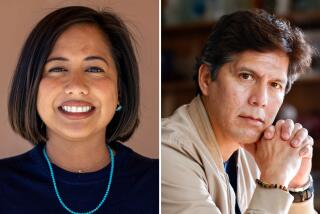Asian Groups Warn of Strife Over Alatorre Remap Plan
A coalition of Asian-American groups Tuesday denounced a redistricting plan that would turn the Los Angeles City Council district represented by the council’s only Asian into a predominantly Latino district as “bad city policy . . . to vindicate the rights of one minority . . . at the expense of another.”
Asian-American leaders representing the Chinese, Filipino, Korean and Japanese communities held a City Hall press conference to oppose a proposal by Councilman Richard Alatorre that would realign 15 council boundaries, including major changes in the Hollywood district now represented by Councilman Michael Woo. Woo’s district, including not only Chinatown but heavily Latino areas in Northeast Los Angeles, would become the second district in the city to have at least a 65% Latino population. Alatorre has the other.
Alatorre, who earlier Tuesday officially unveiled the plan to realign the districts, defended the proposal as the one most likely to receive majority council support. Councilman Gilbert Lindsay predicted that Alatorre “has 10 votes in the pocket.”
Alatorre, the only Latino on the 15-member council, is charged with drawing new district boundaries which, if approved, would reshape the power bases of voter support for the city’s elected officials for years to come. The redistricting plan is in response to a federal lawsuit alleging that the city, when district lines were last redrawn in 1982, violated federal law by establishing boundaries that weakened Latino voting strength.
The Alatorre proposal that shifted Woo’s district more than that of any other council member became known last week. Woo learned then that under it, he would lose his Hollywood base of support and be moved eastward to take over a district that would be two-thirds Latino. An angry Woo blasted the plan and said that if he, an Asian, is forced to run for reelection in a largely Latino district, it would “pit the city’s two fastest-growing minorities against each other” and make it difficult to win reelection.
Alatorre said Tuesday that “I don’t accept the opinion that he (Woo) is likely to be defeated.” Citing the political success of former Councilman Arthur K. Snyder, an Anglo who was repeatedly reelected in a predominantly Latino area, Alatorre said Woo’s chances for reelection “would be determined by the people . . . (as) we learn from Councilman Art Snyder (who) was elected and reelected.”
Woo said Tuesday that while he is “not saying I absolutely couldn’t win” in a 65% Latino district, “I can’t think of any Asian anywhere in the country who won in a 65% Hispanic or black district, it’s part of the political reality. . . . If it’s so easy for minority candidates to win election from other minorities, I wonder why we don’t see (black Councilmen) Gil Lindsay or Dave Cunningham standing in line to get a Hispanic district.”
With the exception of Woo, the other 14 council members appear to have gotten much of what they would naturally want in Alatorre’s proposal. For example, Councilman Joel Wachs--not Councilman John Ferraro, as was first believed--got the bulk of Hollywood, an area that should mesh well with Wachs’ strong stands in favor of the arts and gay rights.
Council President Pat Russell, who has done well with voters in the largely black Crenshaw area, keeps that area in her district. She had been expected to attend Alatorre’s press conference but was noticeably absent. While Woo took her absence as a hopeful sign that she might support an alternative plan that he may present today, others close to Russell suggested that as leader of the council she merely wanted to appear neutral at this point.
Cunningham, whose district is gradually becoming more Latino and Asian, would pick up a larger black population. Ferraro, who has a 40% Latino Central City district now, would have a 50% Anglo district that would go as far northeast as Eagle Rock under Alatorre’s plan.
In determining where the new district lines should go, Alatorre said “a fundamental problem is we’re at least trying to keep people (incumbent council members) in their respective districts.” Ferraro said later that he had told Alatorre that “it was very important to me . . . to remain in my home.” It was important, Ferraro added, because his wife, Margaret, is disabled.
Public hearings on the plan will take place at 1 p.m. and 7 p.m. Thursday in City Hall council chambers. Thereafter, the plan that is eventually adopted must be passed by a majority of the council, is subject to the approval of the mayor and must go before a federal court judge for approval by July 31.
More to Read
Sign up for Essential California
The most important California stories and recommendations in your inbox every morning.
You may occasionally receive promotional content from the Los Angeles Times.










